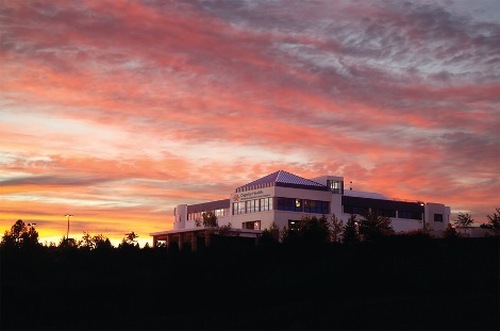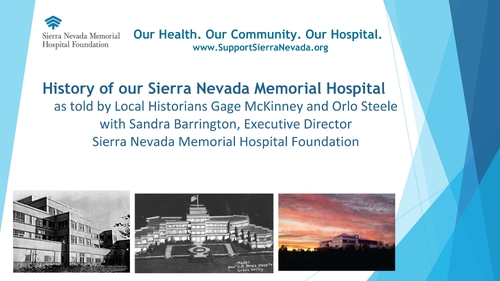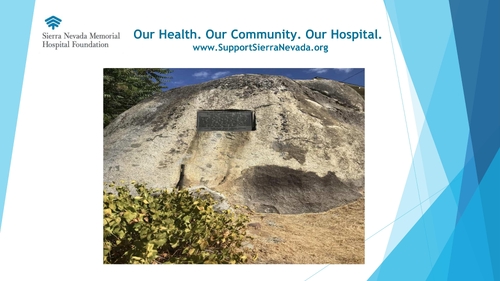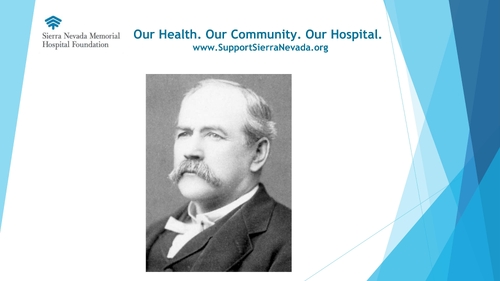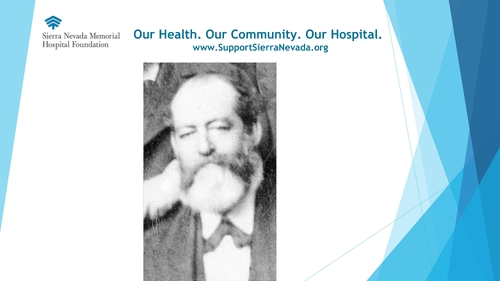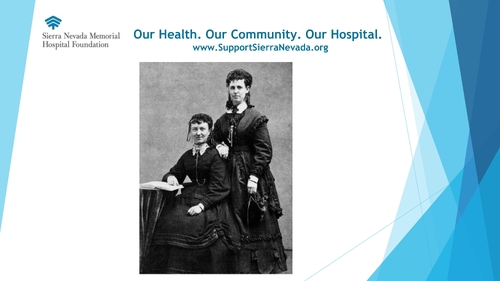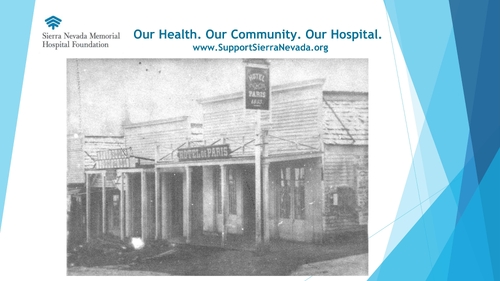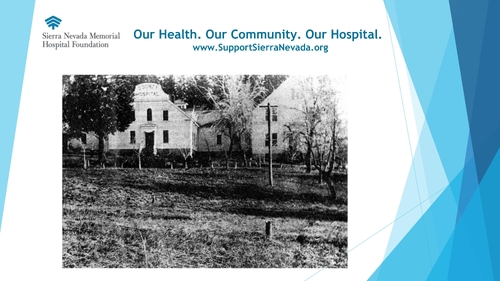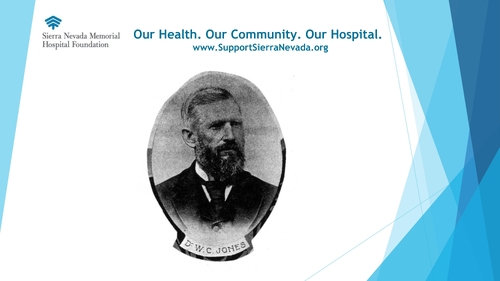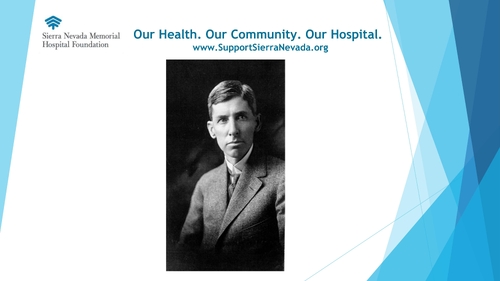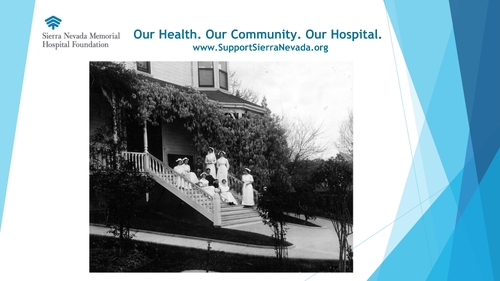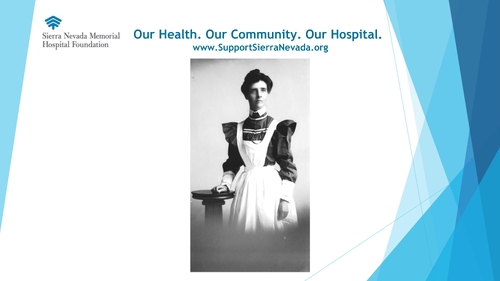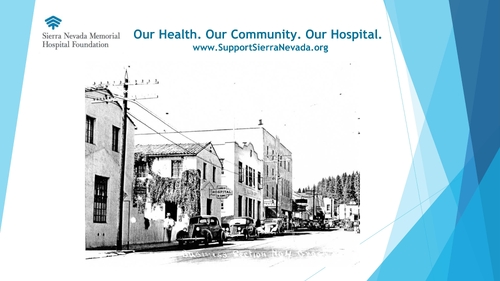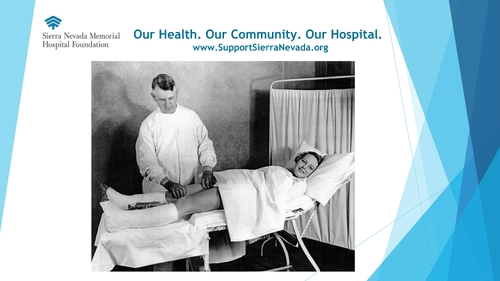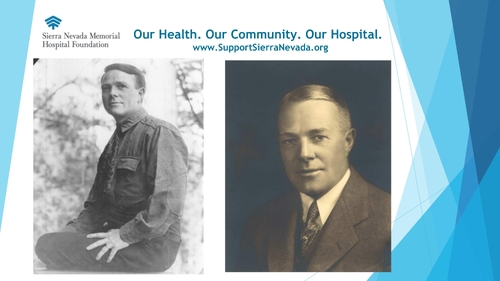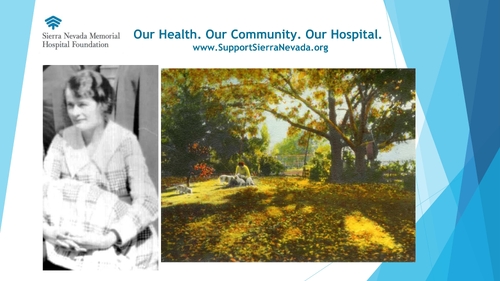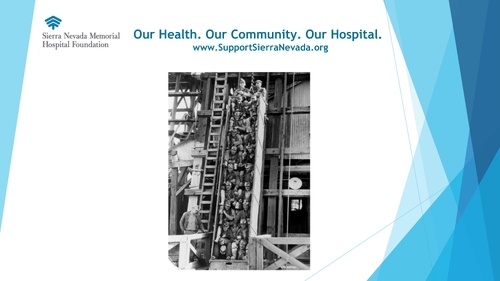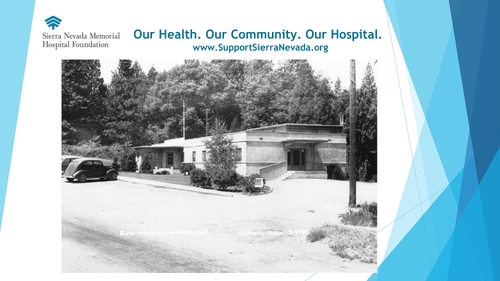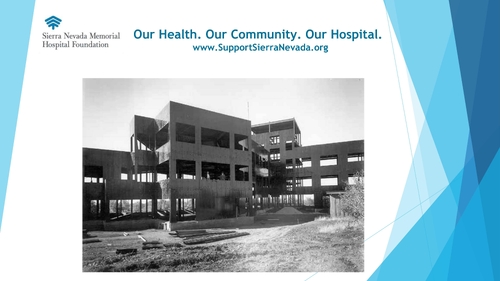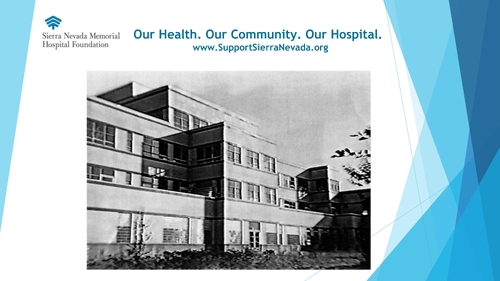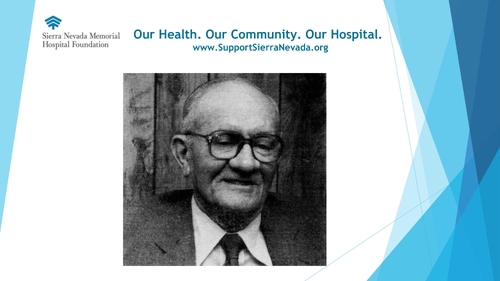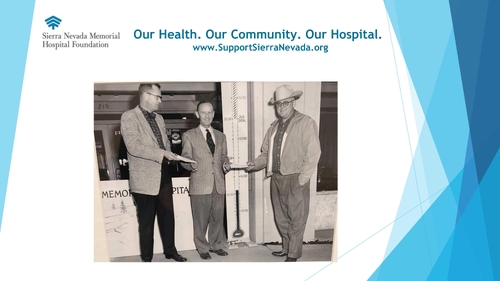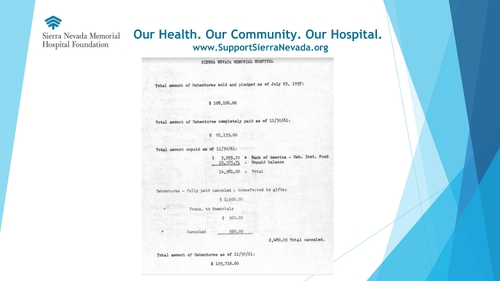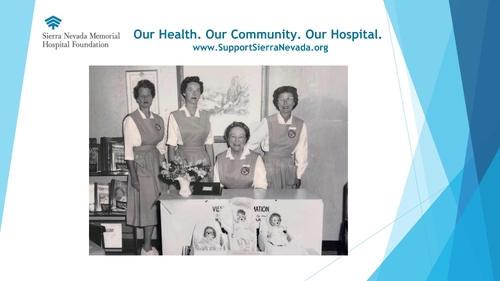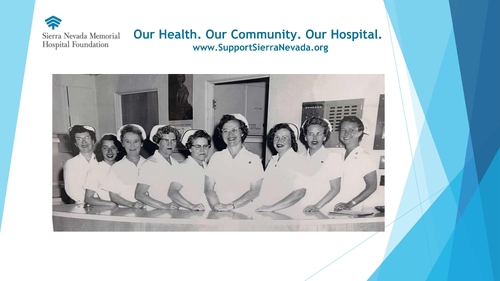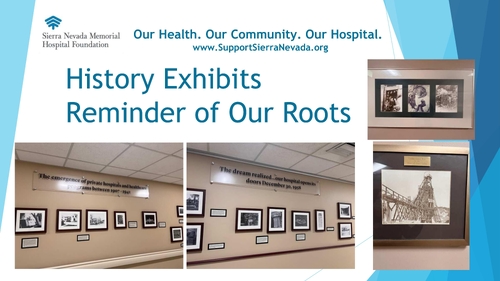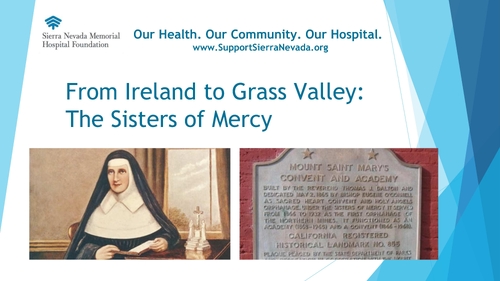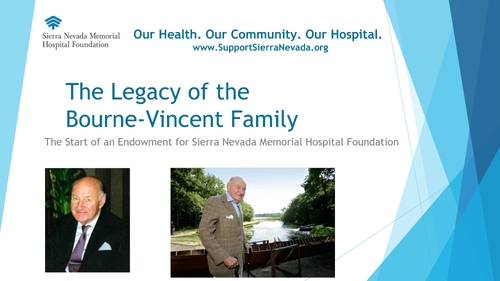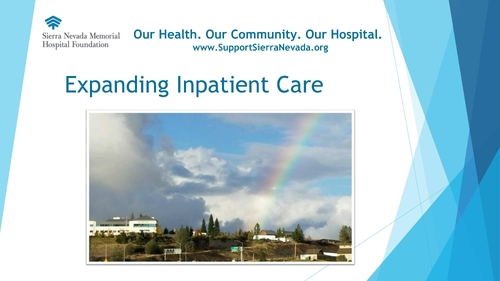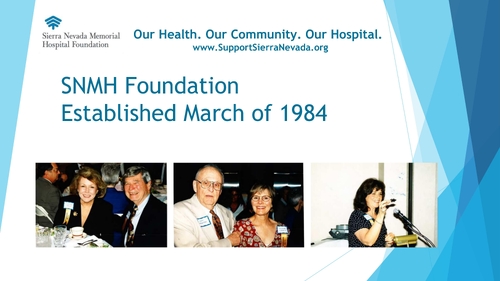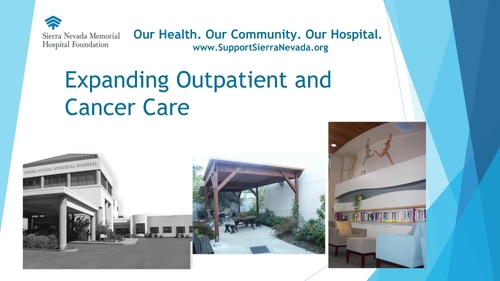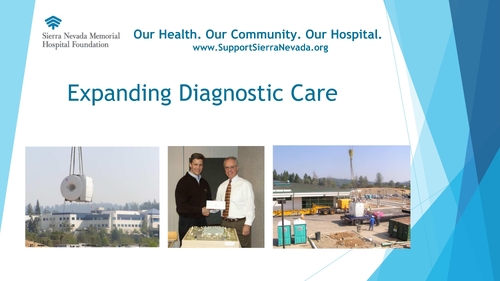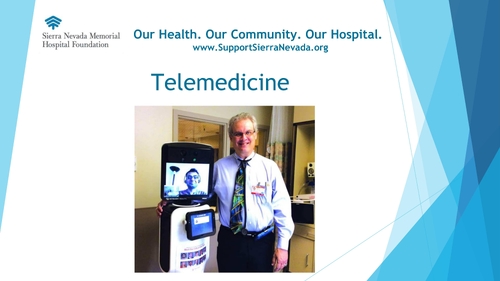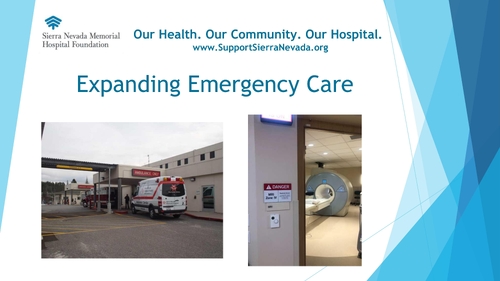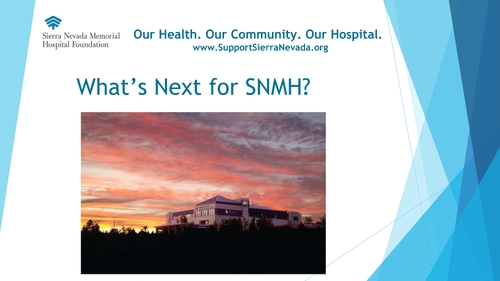Enter a name, company, place or keywords to search across this item. Then click "Search" (or hit Enter).
Collection: Videos > Speaker Nights
Video: 2022-10-20 - History of Sierra Nevada Memorial Hospital with Gage McKinney & Sandra Barrington (48 minutes)
This is the history of the Sierra Nevada Memorial Hospital, as told by local historian, Gage McKinney and Sandra Barrington, Executive Director of the Sierra Nevada Memorial Hospital Foundation.
In 1904, 17-year-old Agnes Foote, daughter of a mine manager, died near Grass Valley from appendicitis. A young mining engineer remembered this and when many years later he became wealthy from gold mining, he dedicated his fortune to building a first-rate local hospital so no other young person would die like Agnes. This is one of the stories behind Sierra Nevada Memorial and the citizens who have made our local hospital more valuable than gold.
Join us for a fascinating story telling of the history of healthcare, Sierra Nevada Memorial Hospital, and its gold mining roots. Learn now that history is still rooted in the Hospital since it was completed in 1958.
In 1904, 17-year-old Agnes Foote, daughter of a mine manager, died near Grass Valley from appendicitis. A young mining engineer remembered this and when many years later he became wealthy from gold mining, he dedicated his fortune to building a first-rate local hospital so no other young person would die like Agnes. This is one of the stories behind Sierra Nevada Memorial and the citizens who have made our local hospital more valuable than gold.
Join us for a fascinating story telling of the history of healthcare, Sierra Nevada Memorial Hospital, and its gold mining roots. Learn now that history is still rooted in the Hospital since it was completed in 1958.
Author: Gage McKinney & Sandra Barrington
Published: 2022-10-20
Original Held At:
Published: 2022-10-20
Original Held At:
Full Transcript of the Video:
And our program tonight, I'm sure you know because it was in the paper and through emails, is the history of who's here in Nevada Memorial Hospital. And our presenters are Sandra Barrington, who's with the foundation. And Gage McKinney, our renowned historian, and Orlo Steele, who knows more about certain things than anybody. They'll be our presenters tonight. And Gage, you and Orlo are going to start off, right? Right. Okay, I've got it. Thank you everyone for being with us tonight. It's my pleasure to be with Sandra and Orlo. And so, of course, we'd like to give a little bit of historical context to our presentation. So should we start 2,500 years ago? That's good. So that's about the time that a medical school was established in Athens, in 400 BCE, the Hippocratic Oath. In China, medicine was progressing down different lines, but at a similar rate. And hundreds of years ago, this is Medicine Rock on East Broad Street in Nevada City. The indigenous people, the Nisanon here, had their own medical practices. And the one that Medicine Rock represents is it's a big boulder that's flat on top, where you could lay patients on the top of that rock in the sunshine, and they would have the bomb of the sun rays on them. Orlo and I are going to switch off talking about slides. Now, we have this very carefully choreographed. If there's any slip-up, and we don't know anything about a slide that appears, I will not be able to explain that. Thank you. As Gage indicated, we're going to double-turn Team U up here. That means if somebody lies, the other one's going to swear to him. The gentleman that's up here is Robert Hunt. He came out as a gold seeker from upstate New York in the 1850s, did pretty well. And then after a couple of years, he decided he could do better by dispensing medicine up here, and he went to work for a druggist. And eventually, he started treating patients. Ultimately, the county appointed him to be the first physician at the county hospital in 1859, and Dr. Hunt took over that position. In the way of historic places, Dr. Hunt built a beautiful Victorian house. It's called the Rector House sometimes. Everybody know that house with the deer up there? He built that house and then did it initially when he was in there. Paige? And beside Dr. Hunt, the doctor in Grass Valley was Dr. McCormick. He was fully established in his medical career in Pennsylvania when he became a 49er at the age of 36 that made him very old in that cohort. He came out via the southern route through the desert and Los Angeles. And his first tried gold mining and very soon went into medical practice. He became the leading medical man besides Dr. Hunt. And he was also very active in local politics, especially in the Civil War era. He was a great exponent for the Union cause and the re-election of Abraham Lincoln in 1864 and the establishment of the Union newspaper, which was established in that election year as well. He became Dr. Hunt practice medicine in this county for decades. The practice until about 1859 when a hospital was established was to rent a property in town and designate that as the county hospital. And it was very unsatisfactory. And here's an example of one that was located next to a Bordello in Nevada City. The Hotel de Paris. But that was the practice until they did finally establish a clinic under the county. I think the county clinic is up now. This has been on the lower road, the county clinic, which started in 1859 and was administered by Dr. Hunt until he died in 1904. It underwent several renovations, but initially it was a 30-bed hospital and then was expanded several times there and it continued to serve the county until 1973. So not all the medical doctors here were male. There were two prominent women doctors both in Nevada City. They both stayed a relatively short time before moving on to more lucrative practices in the Bay Area. And they were looking for the names now. Dr. Holdridge and Dr. Pfeiffer. And those were the first women doctors to practice here. And then we had the first woman dentist in the state of California. That was Dr. Nellie Chapman. Her husband was also a dentist. They were in Nevada City. And when her husband went with the miners to the Comstock load in Virginia City in the early 1860s, Nellie took over the practice and she was the dentist in Nevada City. And so this is the medical man who was probably best remembered in the county because eventually a hospital was named for him and that was William C. Jones. He was actually in medical school back east when the gold rush happened and he left medical school to come out and try his luck in the mines and recognized the need for medical people in California. And so he went to San Francisco to the Cooper Medical School and completed his education. He also went back to New York for advanced training and he became the doctor initially for the Central Pacific Railroad when it was building the Transcontinental Railroad and especially here into the mountains and across the deserts towards Utah. He then set up a practice in Truckee, was there for a number of years and saw a greater need in Grass Valley and so established his practice in Grass Valley in 1874 and continued until he died about 1900. This is John Jones who was a son and also who went to Cooper College in San Francisco. This later became Stanford University's Medical School. It was known as Cooper's College. John was an early doctor. He was the first one to, he was a very fine surgeon and bought a home there on South School Street and started to plan that as a hospital. He was a very, very fine athlete and particularly in tennis and he was down at the Del Coronado Hotel and dove into the water and his head hit the sand and he became paralyzed and he was never able to walk again. A family tried a number of places throughout Europe to assist him but none of those were successful. That was Dr. John who was well known in this community and he was the first one to convert the Jones to a hospital in 1907. This is the hospital. Do we have anybody who's ever been, was born in the Jones Hospital? Any other patients from the Jones Hospital? Remember it very well. Oh and this is a picture of the Jones Hospital with the staff of nurses and with John and his brother, Carla, who had just moved here about 1908. The Joneses were very keen for public health and very supportive of nurses in this community, just anticipating. And so one of the leading nurses who established the Nevada City Sanatorium on Coyote Street was Elizabeth McDonald Watson. Was that the picture? Someone was looking for this picture. And her partner in that was Laura Peterson. Nurse Watson was born in Scotland, trained in the East, got her practical cold experiences as a nurse in California, and actually ultimately got her nursing credential by correspondence from a nursing school in New York State. She operated this hospital which was responsible by 1946 for 3,000 births in this county and also took care of the aged as well. This is another one for you old timers who might remember this one. It was called the Landis Hospital or we call it Community Hospital on Auburn Street. It was located on the second floor of the old NID building between Bank Street and Neil Street. It was started and run by Dr. Lang, but it served as a medical center and a small clinic and a hospital for grad salary from about 1933 until its closure in 1950, in the mid 1950s. That was called Community Hospital. Everybody remember that? And this is the man who became Grass Valley's doctor. It's Dr. William Jones' third son who became a medical doctor. The fourth son became a county judge. This is Dr. Carl Power Jones and beside a medical invention that he patented, Dr. Jones originally started his training at the School of Mines at the University of California, Berkeley, but then switched to medicine and followed his brothers into the practice and eventually was the surviving brother so that he ran the hospital. He was famous for a lot of things, for being quick with a scalpel, a very decisive doctor. He was famous for treating people who were injured in any circumstances. Once sewing up a man who was wounded in a hunting accident by the side of the road, once setting a boy's leg on the street by the like of his headlights, he would go anyplace that he was called in Grass Valley or indeed throughout this county. When he was at Cal, playing baseball on the boxing team, thinking of becoming a mining engineer, he met another student named Aaron McBoyle. Aaron McBoyle was a graduate of the Hearst School of Mines at Berkeley and later of Columbia, the oldest mining school in America. He came to Grass Valley and it's a story for another time, but over a 20 years effort, game controlled the Idaho Maryland mine and made that mine into the richest gold mine in California after eminent geologists and engineers said it was worked out and that it could not be done. So this is something to know about Aaron McBoyle. He ended up being very rich. He had this rich gold mine, he had other rich mining properties, he had a large estate known as Loma Rica, which is a landmark in this area. He had multiple horse ranches. He had his own dairy. He had a thoroughbred ranch and his horses won races and racetracks all over the state and indeed all over the country. His wife was a socialite in San Francisco, written up in all the society pages. He had a Lockheed electric aircraft, the same one that Emilia Earhart flew. And before he had any of that, before he had any of those riches, in 1934 with his long time friend Dr. Jones, he created a charitable corporation by which he would give all of his stock from the Idaho Maryland mine over the course of time to build a hospital. And so that 1934 Grass Valley Memorial Hospital Corporation was the parent, the grandparent of our Sierra Nevada Memorial Hospital. That's yours also and we'll come back to that. One of the Grass Valley Memorial Hospital was under construction. The Newmont Mining Company similarly started their own hospital, which was in Nevada City, called Miner's Hospital. It was a 20-bed hospital, billed for $60,000, and opened in 1940 and served the community for quite some time. Miner's Hospital is one that I'm sure all of you remember and a very fine hospital and a good staff. Norman, no, I'm trying to think of Norman. Anyway, it was built for the miners from the Empire, that is the Empire Mine, the North Star, the Zibrite, and the Merchie Mines. And miners paid a very, very small amount, less than a dollar, I think. And for that they got medical treatment for themselves as well as their families from the Newmont Mining, primarily from Miner's Hospital. Here are some of Mr. McBoyle's miners at the Idaho Maryland mine going down for their shift, where they also had a health scheme. And this is an original conceptual drawing of the hospital that Dr. Jones and Mr. McBoyle planned to build. Dr. Jones toured hospitals all over America, including the Mayo Clinic and major hospitals in New York and elsewhere. He toured hospitals in New Europe and took notes and brought home ideas for the best designs and best practices. And Errol McBoyle's brother-in-law, Mr. Clifford, who worked for Julia Morgan as an architect, he designed this building. Now if you notice on this slide, it says the C. P. Jones Memorial Hospital. And I'm pretty sure that's a gag. It was never intended to be the Carl P. Jones Hospital, and I think it was a conceptual drawing, and so they were just kind of winding up Dr. Carl. This building we now know as the Linton Building. And what happened in the Second World War, this building was not complete, only the outer shell was complete when the war began in Europe. And then steel and hospital fixtures and other materials were not available to finish the hospital. And so it sat up on the hill where the Linton Building is beside a parrot orchard, unfinished for many years. And Mr. McBoyle had a stroke. The mines were closed by World War II. When they reopened, of course, they were not as rich as they had been. And so a new plan had to be developed for how to make this hospital a reality. And so some new players come into the story, and one of them is Charles Linton, who came to this area, fell in love with this part of California, brought his engineering facilities to this area, bought the Linton Building to house his operation, and the sale of that building, the $200,000, became the nest egg for our community hospital. And then Glendeline McBoyle, Errol's wife, also became involved after Errol had died, and trying to keep this original foundation and this original plan together, she was approached about giving a new site for the hospital. And it was chosen on Spring Hill midway between Grass Valley and Nevada City that made it politically viable in those days. And so Mrs. McBoyle actually gave the hospital property twice, first where the Linton Building is, and then on Spring Hill. It was Mrs. McBoyle's second husband, Singfried Beckhold, who told the foundation board, "The mine is never going to recover. " This is about 1954. "It's never going to recover enough to pay for this hospital and fulfill the original plan. You must turn to the people. " And so Charles Linton was invited to become the head of a Citizens Committee, and he held a meeting for that committee at the Linton Building in 1956, and he asked the people who were assembled, there were over 100 people, all the real leaders of Grass Valley, Nevada City, Downingville, the people who could make things happen. And Linton asked those assembled whether they believed there was a definite need for a new hospital. Every hand in the room was raised. He asked, "How many of you would be willing to serve on the general committee?" Again, every hand was raised. "How many would be willing to pledge money?" Again, every hand. "How many believe we could do this?" And the room erupted in applause and shouts, and people were ready to act. In order to be able to build, they came up with a scheme of selling debentures to the community, and we have an example of one of those debentures. And if a person, it's like a script, and if they had money that was not used over the years, they could apply whatever was left in that debenture towards their hospitalization fees that came up. It was a master stroke of being able to raise money. And what you see right up here is an example of the debenture and how much money a person put into that one. This is a picture of some of the leadership in front of the Alpha Hardware in Nevada City, and you see Don Newton, Downey Clench, and Stan Hall, who was the treasurer. And they had a big thermometer there that kind of let the community know where they were in response to getting money for the new hospital, and they were able to raise the money so that they could begin construction by about 1958 in there. Next. Oh, this is an example of the debenture. This is a photograph of the first volunteers after the hospital was started. And that CD breaks over on the right, Bernice Glassen, in the center, and Dorie Clench, and I'm not sure who the other person is, but they were starting the volunteer program at Sierra Nevada Memorial Hospital. I don't know how many of you know that it really represents two counties, Sierra County and Nevada County, and that's how it got its name in back of here. Any questions thus far? Paige. Before we turn it over to Sandra for the rest of the story, we have a transitional figure. It's Sylvia's dad. It's Malcolm Hamill. And he was raised in this county. He was about a third generation, fourth generation in this county. His original family members here had been Cornish miners, and he wanted to be a cowboy. And he served on the, worked on the family ranches out in Ruffin, Reddy, and Penn Valley. Got a good education at the agricultural school operated by the University of California at Davis. And he eventually became Mr. McBoyle's right hand man in managing his property. I mentioned all the ranches. So Mr. Hamill managed all of those ranches, all of the livestock, all of the agribusiness that Mr. McBoyle was involved in. And he became involved in all of the McBoyle's activities and became an aide and a support to Mrs. McBoyle after she was widowed. And as Mr. McBoyle was fading and his life was ending, Malcolm Hamill promised that he would see the hospital through. And indeed he did. He served on the hospital board, often as president, almost always as vice president for over 30 years. And he was a man who brought in Charles Linton, brought in so many other key players like Mrs. Glassen and others. And the hospital story is very much his story too. And now for the rest of the story. Yes, one more. Let me just add a footnote on Bernice Glassen. How many remember Bernice Glassen? If there's ever a person who should be rated as the matriarch of this community as Bernice Glassen. Her mother was French. Her father was Cornish. And she never married until later on and very late in life. David Mann and I took French from her in 1945. Our mother persuaded her to do that. Until she was called away to be an interpreter for the United Nations charter that was being set up at the San Francisco Opera House. And she became an interpreter down there. Bernice Glassen was a wonderful person and wanted this community also a great deal too. Thank you. And so the next time you drive up towards the hospital, you'll see the street sign that says "Glassen" and you'll know the story. Thank you so much, Orlo Engage, our local health care historians. I haven't heard that in a long time and so it's wonderful to be reminded of all that history. You might recognize some people in this photo. This is the first day the hospital opened on December 31, 1958. You might notice Mary Grace Tassoni is in that picture. And she's on the far, I guess that's the left of me. And this is a lot of the nurses at the first day of the hospital and Mary Grace Tassoni worked at the hospital until not that long ago. And actually if you go into the main lobby of our hospital and go down towards the patient rooms, you'll see our chapel, which is now called the Place of Grace. And it's named after Mary Grace Tassoni. So the hospital history is very important to us. It is so important to us that we created a very similar exhibit of what you've seen today, the pictures and what Orlo Engage had talked about. There is an exhibit off of the emergency department near the inpatient diagnostic imaging and next to the cafe. And it starts at Medicine Rock and goes all the way to the opening day of the hospital. So we still showcase the history of the hospital and daily reminders of how deep the roots are in this community and how important that history is and the mining history and the people who helped build this hospital. And these other pictures here, we have a lot of mining pictures around the hospital as well. So when you're walking around, you might see those because the mining history is so important because it really was truly the minds that helped make sure we had great health care in our community. And I wanted to go way back. We're going to go way back again to 1827 Dublin, Ireland to Sister Catherine Macaulay. And Sister Catherine Macaulay in Ireland received an inheritance of a family that she cared for. And she started the Sisters of Mercy. She created orphanage and health care facilities across Ireland and in England as well. And the Sisters of Mercy became so big that they arrived in the United States at the invitation of the Bishop of Pittsburgh, Pennsylvania. And that was about 1843. And they grew across the country. They came to New York. They came to Chicago. They came to Arkansas, San Francisco, Sacramento. And they spread the works of the Sisters of Mercy and built schools and convents and hospitals and really started the modern day health care systems in the United States. And a lot of that came from religious organizations you see at Venice hospitals, you see Dominican hospitals. And that's really how large health care systems started in our country is through a lot of those religious based organizations. And in 1857, the Sisters of Mercy came to our Gold Rushtown and they started a convent and a school, which is now Mount St. Mary's. So Sister Catherine Macaulay, Sisters of Mercy started health care, started Mount St. Mary's. So the history of that goes back a lot in our community. So why is that important to today? So a lot of history with the hospital and the affiliations with the hospital. And about in the 90s, a lot of you will remember this, the hospital affiliated with Mercy Health Care, which named themselves Catholic Health, Catholic Health Care West. And the hospital was the very first, Sierra Nevada was the very first hospital to make that affiliation with Mercy Health Care and Catholic Health Care West. And we started and created the first affiliation agreement with that system. And to this day, that hospital system still uses that first affiliation agreement. So Sierra Nevada helped build those core values of what that larger system is. That name changed to Dignity Health, which is now the name of our hospital, but also merged with another organization which created Common Spirit Health, which is now the largest nonprofit health care system in the country. But it all started with that original affiliation with Sierra Nevada and the Sisters of Mercy originally. And to think that all really started with one sister in Ireland coming all the way out here, creating that and then that affiliation agreement. But through all of that change in the health care system, the health care industry, Sierra Nevada has always remained a very independent affiliate of the system. And we still have our own local board of directors. And you'll see on our slides and our tagline, we say our hospital, our community, our health care, because it is our hospital and it will always remain our hospital. I wanted to highlight a name a lot of people know from the mining history. But this is Mr. Billy Vincent and his grandparents were one of the owners of Empire Mine. And the legacy of the board of Vincent family is pretty incredible and he donated a lot of money to the hospital in the beginning of memory of his grandparents. This family also owned the Macross House in Clarnie, Ireland and the Fioli in the Bay Area and also helped build the Culinary Institute building that's in St Helena. So the family has a lot of roots in California. And in addition to the donations that he made to build the hospital, Billy Vincent made the hospital foundation an income beneficiary of the born Vincent estate. And during his lifetime, the hospital foundation created a fairly significant endowment to our general endowment. And during his lifetime, we were income beneficiaries of that. And that trust ended at his life, which then went to his great nephew. So a lot of legacies in that and helping us build our endowment fund. So what's happened since 1958, you know, it broke ground as a 42 bed hospital inpatient facility and it took its first patient on December 31st of 1958. And then construction projects changed over the years in 1971 and 1984 and all through community contributions. And there was always an emphasis on inpatient care and increasing the number of beds. And it went up to 71 beds and the highest number of beds at one point at 124 beds. And today we're a 104 bed hospital. At one point we had a transitional care unit. And so when we close that, that was closure of 20 beds. So we're now at 104 acute beds. And in 1984, this little organization called the Hospital Foundation came along and started a formal foundation for the hospital. And there was a dedicated group of volunteers who really wanted to make sure that this hospital had support for many, many years to come. And the study group included Gay Prior, Curtis Grimes, John Keatoners, Bill Briggs, and others that really set the tempo. And as the story has been told to me, the Hospital Foundation actually started in the barn on Gay Prior's property. And many of you know Corinne Prior as well that's pictured up there, who really helped start the Hospital Foundation. And so eventually we did become a 501(c)(3) in March of 1984. So the initial plan for the foundation was to build the endowment. And once it came $500,000 in 1989, they really started to build for today's need. Many of you know Pamela Comstock, who became the first formal executive director of the organization. And then after that, Kimberly Parker, who left the organization in July. And I was fortunate enough to be chosen to take over. In the 90s, the foundation did a lot of work and they infused the hospital with about $1. 3 million in the 90s. Today we raise anywhere between $1. 6 and $2 million in a year, which is very exciting. So we've done a lot of work expanding outpatient and cancer care. In the 90s, the hospital expanded to create a brand new outpatient center and cancer center. And the cancer center now serves 20,000 patient visits a year, very, very busy with a full infusion center and full radiation oncology, including a linear accelerator. And the outpatient center is also home to some other services, including surgeries, outpatient surgeries, and our cardiology department, and our cardiac rehab department, which is all nationally accredited. We've also expanded diagnostic care. The Diagnostic Imaging Building, which is also known as Building 4 to some people, was built in 2006. The foundation raised $1. 2 million for that. And that building now has full women's imaging with 3D mammography, whole breast ultrasound, stereotactic biopsy. And the center also has X-ray, MRI, and a CT scanner. For many years, the hospital operated its own lab out of there, but now Quest Lab manages the lab that's there. Oh, and you might recognize Matt Weaver and Tom Collier, who was a former CEO of the hospital. And Matt was very happy to present that check. And Jerry Ann goes in the audience. He is a former board member of the foundation and the past president, and was very involved in that project as well. We've also expanded cardiology care quite a bit, diagnostic cardiology, and then post-care with our cardiac rehab. So when you go in for your stress echoes and you go in for your ultrasounds on your heart, a lot of work has been done to expand the cardiac care at our hospital. Telemedicine is very important. You might notice, remember this guy? Remember, he's around all the time. Dr. Lace, very important part of our ICU. We've expanded telemedicine quite a bit over the years. It's very interesting to walk into the intensive care unit, and there's just a robot moving around, and it has a doctor face on the screen, and it's checking in on patients. We're still a small rural hospital, so we can't be everything to everyone. So we do utilize telemedicine a lot to connect with other specialists that are in the dignity health system that can be there in a moment's notice when we need them, like intensivists in the ICU, also neurology for stroke care down in our emergency department, and then neonatal care in our family birth center. So you'll see a lot of these little robots around the hospital in different places. And we've expanded a lot in emergency care. Our emergency department serves over 35,000 patients visits a year. It's busier than some emergency departments down in the Sacramento area, partly because we're the only one for about 45 minutes, but also because there are so many great services that are offered, and we expanded also the inpatient diagnostic imaging, which is important for our stroke program. So we have full MRI, full CT scans, and a very busy emergency department. Recently we did some renovations to add some private rooms to make the crisis area more private and more secure and add some safety measures to the emergency department. So what's next? What's next for Sierra Nevada? Health care is very interesting these days. I don't know if anyone's noticed that. The industry is changing. One of the things that is a really big priority for the hospital right now is physician recruitment. If I asked for a raise of hands of how many people have had a hard time finding a physician, I'm sure everyone would raise their hand. So that is a really big priority for the hospital right now and for the community. Currently we are developing a family practice primary care residency program. So we're just going to become a teaching community. We are going to start training doctors in our community for family practice. That's in collaboration with Methodist Hospital and Chapa Day Indian Health. Starting in July, we will have two new residents training and coming up here on rotation, and by 2025 we'll have six residents training. And the idea is that they train here, they stay here. Recruitment is really huge for a cardiologist. We're really looking for a cardiologist. If you know anybody, send them this way. We would love to have a couple more. So those are our big priorities right now. And priorities are always finding services that can keep people in our community for care and anything that we can do to keep people local. So looking at different services that make it so you don't have to go down the hill. Like can we be a heart attack receiving center? Can we be a level three trauma center? Things that keep people close to home. Because when you're close to home, you're with your network, you're with your family, you're where you need to be. So thank you so much for your time. Really appreciate everyone coming tonight. And I'm sure we're open to questions if anyone has any questions. The history ones go to these guys. They know all the good stuff. Any questions? When did Miners Hospital close? When did Miners Hospital close? I'm not sure. No, I'm not sure. I think they use it for other purposes rather than a hospital. But I think when this corner is into the 60s, I think. Possibly into the 60s? No, I mean, excuse me, the 90s. Oh, the 90s. And then there was a medical clinic. It was Western Sierra Medical Clinic at one point. Now it's the college story beta. So there's still medicine happening there. That's good. Yes, Bob? This is a question I think we all have. During the Gold Rush era, it started out with Nevada County developing a hospital. It's important. So that doesn't happen in Maryland. And to speak to that transition at all, is it just a gradual thing that they can't get private support from the foundation? Or was it a conscious effort on the part of the county to stop supporting that? No. In the system of how healthcare was supported, is that the question? You know, I'm not really sure of that. I know it was very community driven, very driven by the need to provide care to the Miners in the community and for the minds to support the healthcare of their workers. It covers two counties, Sierra County and Nevada County. That's not what gets us made Sierra Nevada Memorial. Do you want to address that? So across the United States, there was a movement supported, encouraged by the federal government to have community-based hospitals. And so I think that movement was really, got into high gear after World War II. And so it was a government effort to have communities take responsibility for their hospitals. And there were very generous federal grants to help communities do that. Here in Nevada County, Bernice Glasson was the person who went to San Francisco and Los Angeles and explored these federal grants. And in Nevada and Sierra Counties, they said, "Look, it's going to take us years to get one of those federal grants, and we want action now. " And that's why they started planning the hospital in '56, the Citizens Committee, and it opened in December of '58. So that's how much impetus there was here to have a community hospital. The early physicians were then medically educated, McCormick and I can't remember the other one. Yes, yes. They went to the best medical schools of their day. And Dr. Jones went to a school in the east and then down to Cooper, which Cooper has continued, and you now know it at Stanford Medical School. And so they had the best educations available and then the nurses we showed got their training. Some of them read medicine in doctors' offices and were supervised by doctors. That's how some early nursing began. But by the 1920s, you had nurses coming out of nursing schools at Stanford and other places, and they were licensed and accredited. And the great name in this county, because she was the first public health nurse, is Isabel Heffelfinger. Thank you. Any other questions? Okay, well, let's thank our presenters. (Applause)
And our program tonight, I'm sure you know because it was in the paper and through emails, is the history of who's here in Nevada Memorial Hospital. And our presenters are Sandra Barrington, who's with the foundation. And Gage McKinney, our renowned historian, and Orlo Steele, who knows more about certain things than anybody. They'll be our presenters tonight. And Gage, you and Orlo are going to start off, right? Right. Okay, I've got it. Thank you everyone for being with us tonight. It's my pleasure to be with Sandra and Orlo. And so, of course, we'd like to give a little bit of historical context to our presentation. So should we start 2,500 years ago? That's good. So that's about the time that a medical school was established in Athens, in 400 BCE, the Hippocratic Oath. In China, medicine was progressing down different lines, but at a similar rate. And hundreds of years ago, this is Medicine Rock on East Broad Street in Nevada City. The indigenous people, the Nisanon here, had their own medical practices. And the one that Medicine Rock represents is it's a big boulder that's flat on top, where you could lay patients on the top of that rock in the sunshine, and they would have the bomb of the sun rays on them. Orlo and I are going to switch off talking about slides. Now, we have this very carefully choreographed. If there's any slip-up, and we don't know anything about a slide that appears, I will not be able to explain that. Thank you. As Gage indicated, we're going to double-turn Team U up here. That means if somebody lies, the other one's going to swear to him. The gentleman that's up here is Robert Hunt. He came out as a gold seeker from upstate New York in the 1850s, did pretty well. And then after a couple of years, he decided he could do better by dispensing medicine up here, and he went to work for a druggist. And eventually, he started treating patients. Ultimately, the county appointed him to be the first physician at the county hospital in 1859, and Dr. Hunt took over that position. In the way of historic places, Dr. Hunt built a beautiful Victorian house. It's called the Rector House sometimes. Everybody know that house with the deer up there? He built that house and then did it initially when he was in there. Paige? And beside Dr. Hunt, the doctor in Grass Valley was Dr. McCormick. He was fully established in his medical career in Pennsylvania when he became a 49er at the age of 36 that made him very old in that cohort. He came out via the southern route through the desert and Los Angeles. And his first tried gold mining and very soon went into medical practice. He became the leading medical man besides Dr. Hunt. And he was also very active in local politics, especially in the Civil War era. He was a great exponent for the Union cause and the re-election of Abraham Lincoln in 1864 and the establishment of the Union newspaper, which was established in that election year as well. He became Dr. Hunt practice medicine in this county for decades. The practice until about 1859 when a hospital was established was to rent a property in town and designate that as the county hospital. And it was very unsatisfactory. And here's an example of one that was located next to a Bordello in Nevada City. The Hotel de Paris. But that was the practice until they did finally establish a clinic under the county. I think the county clinic is up now. This has been on the lower road, the county clinic, which started in 1859 and was administered by Dr. Hunt until he died in 1904. It underwent several renovations, but initially it was a 30-bed hospital and then was expanded several times there and it continued to serve the county until 1973. So not all the medical doctors here were male. There were two prominent women doctors both in Nevada City. They both stayed a relatively short time before moving on to more lucrative practices in the Bay Area. And they were looking for the names now. Dr. Holdridge and Dr. Pfeiffer. And those were the first women doctors to practice here. And then we had the first woman dentist in the state of California. That was Dr. Nellie Chapman. Her husband was also a dentist. They were in Nevada City. And when her husband went with the miners to the Comstock load in Virginia City in the early 1860s, Nellie took over the practice and she was the dentist in Nevada City. And so this is the medical man who was probably best remembered in the county because eventually a hospital was named for him and that was William C. Jones. He was actually in medical school back east when the gold rush happened and he left medical school to come out and try his luck in the mines and recognized the need for medical people in California. And so he went to San Francisco to the Cooper Medical School and completed his education. He also went back to New York for advanced training and he became the doctor initially for the Central Pacific Railroad when it was building the Transcontinental Railroad and especially here into the mountains and across the deserts towards Utah. He then set up a practice in Truckee, was there for a number of years and saw a greater need in Grass Valley and so established his practice in Grass Valley in 1874 and continued until he died about 1900. This is John Jones who was a son and also who went to Cooper College in San Francisco. This later became Stanford University's Medical School. It was known as Cooper's College. John was an early doctor. He was the first one to, he was a very fine surgeon and bought a home there on South School Street and started to plan that as a hospital. He was a very, very fine athlete and particularly in tennis and he was down at the Del Coronado Hotel and dove into the water and his head hit the sand and he became paralyzed and he was never able to walk again. A family tried a number of places throughout Europe to assist him but none of those were successful. That was Dr. John who was well known in this community and he was the first one to convert the Jones to a hospital in 1907. This is the hospital. Do we have anybody who's ever been, was born in the Jones Hospital? Any other patients from the Jones Hospital? Remember it very well. Oh and this is a picture of the Jones Hospital with the staff of nurses and with John and his brother, Carla, who had just moved here about 1908. The Joneses were very keen for public health and very supportive of nurses in this community, just anticipating. And so one of the leading nurses who established the Nevada City Sanatorium on Coyote Street was Elizabeth McDonald Watson. Was that the picture? Someone was looking for this picture. And her partner in that was Laura Peterson. Nurse Watson was born in Scotland, trained in the East, got her practical cold experiences as a nurse in California, and actually ultimately got her nursing credential by correspondence from a nursing school in New York State. She operated this hospital which was responsible by 1946 for 3,000 births in this county and also took care of the aged as well. This is another one for you old timers who might remember this one. It was called the Landis Hospital or we call it Community Hospital on Auburn Street. It was located on the second floor of the old NID building between Bank Street and Neil Street. It was started and run by Dr. Lang, but it served as a medical center and a small clinic and a hospital for grad salary from about 1933 until its closure in 1950, in the mid 1950s. That was called Community Hospital. Everybody remember that? And this is the man who became Grass Valley's doctor. It's Dr. William Jones' third son who became a medical doctor. The fourth son became a county judge. This is Dr. Carl Power Jones and beside a medical invention that he patented, Dr. Jones originally started his training at the School of Mines at the University of California, Berkeley, but then switched to medicine and followed his brothers into the practice and eventually was the surviving brother so that he ran the hospital. He was famous for a lot of things, for being quick with a scalpel, a very decisive doctor. He was famous for treating people who were injured in any circumstances. Once sewing up a man who was wounded in a hunting accident by the side of the road, once setting a boy's leg on the street by the like of his headlights, he would go anyplace that he was called in Grass Valley or indeed throughout this county. When he was at Cal, playing baseball on the boxing team, thinking of becoming a mining engineer, he met another student named Aaron McBoyle. Aaron McBoyle was a graduate of the Hearst School of Mines at Berkeley and later of Columbia, the oldest mining school in America. He came to Grass Valley and it's a story for another time, but over a 20 years effort, game controlled the Idaho Maryland mine and made that mine into the richest gold mine in California after eminent geologists and engineers said it was worked out and that it could not be done. So this is something to know about Aaron McBoyle. He ended up being very rich. He had this rich gold mine, he had other rich mining properties, he had a large estate known as Loma Rica, which is a landmark in this area. He had multiple horse ranches. He had his own dairy. He had a thoroughbred ranch and his horses won races and racetracks all over the state and indeed all over the country. His wife was a socialite in San Francisco, written up in all the society pages. He had a Lockheed electric aircraft, the same one that Emilia Earhart flew. And before he had any of that, before he had any of those riches, in 1934 with his long time friend Dr. Jones, he created a charitable corporation by which he would give all of his stock from the Idaho Maryland mine over the course of time to build a hospital. And so that 1934 Grass Valley Memorial Hospital Corporation was the parent, the grandparent of our Sierra Nevada Memorial Hospital. That's yours also and we'll come back to that. One of the Grass Valley Memorial Hospital was under construction. The Newmont Mining Company similarly started their own hospital, which was in Nevada City, called Miner's Hospital. It was a 20-bed hospital, billed for $60,000, and opened in 1940 and served the community for quite some time. Miner's Hospital is one that I'm sure all of you remember and a very fine hospital and a good staff. Norman, no, I'm trying to think of Norman. Anyway, it was built for the miners from the Empire, that is the Empire Mine, the North Star, the Zibrite, and the Merchie Mines. And miners paid a very, very small amount, less than a dollar, I think. And for that they got medical treatment for themselves as well as their families from the Newmont Mining, primarily from Miner's Hospital. Here are some of Mr. McBoyle's miners at the Idaho Maryland mine going down for their shift, where they also had a health scheme. And this is an original conceptual drawing of the hospital that Dr. Jones and Mr. McBoyle planned to build. Dr. Jones toured hospitals all over America, including the Mayo Clinic and major hospitals in New York and elsewhere. He toured hospitals in New Europe and took notes and brought home ideas for the best designs and best practices. And Errol McBoyle's brother-in-law, Mr. Clifford, who worked for Julia Morgan as an architect, he designed this building. Now if you notice on this slide, it says the C. P. Jones Memorial Hospital. And I'm pretty sure that's a gag. It was never intended to be the Carl P. Jones Hospital, and I think it was a conceptual drawing, and so they were just kind of winding up Dr. Carl. This building we now know as the Linton Building. And what happened in the Second World War, this building was not complete, only the outer shell was complete when the war began in Europe. And then steel and hospital fixtures and other materials were not available to finish the hospital. And so it sat up on the hill where the Linton Building is beside a parrot orchard, unfinished for many years. And Mr. McBoyle had a stroke. The mines were closed by World War II. When they reopened, of course, they were not as rich as they had been. And so a new plan had to be developed for how to make this hospital a reality. And so some new players come into the story, and one of them is Charles Linton, who came to this area, fell in love with this part of California, brought his engineering facilities to this area, bought the Linton Building to house his operation, and the sale of that building, the $200,000, became the nest egg for our community hospital. And then Glendeline McBoyle, Errol's wife, also became involved after Errol had died, and trying to keep this original foundation and this original plan together, she was approached about giving a new site for the hospital. And it was chosen on Spring Hill midway between Grass Valley and Nevada City that made it politically viable in those days. And so Mrs. McBoyle actually gave the hospital property twice, first where the Linton Building is, and then on Spring Hill. It was Mrs. McBoyle's second husband, Singfried Beckhold, who told the foundation board, "The mine is never going to recover. " This is about 1954. "It's never going to recover enough to pay for this hospital and fulfill the original plan. You must turn to the people. " And so Charles Linton was invited to become the head of a Citizens Committee, and he held a meeting for that committee at the Linton Building in 1956, and he asked the people who were assembled, there were over 100 people, all the real leaders of Grass Valley, Nevada City, Downingville, the people who could make things happen. And Linton asked those assembled whether they believed there was a definite need for a new hospital. Every hand in the room was raised. He asked, "How many of you would be willing to serve on the general committee?" Again, every hand was raised. "How many would be willing to pledge money?" Again, every hand. "How many believe we could do this?" And the room erupted in applause and shouts, and people were ready to act. In order to be able to build, they came up with a scheme of selling debentures to the community, and we have an example of one of those debentures. And if a person, it's like a script, and if they had money that was not used over the years, they could apply whatever was left in that debenture towards their hospitalization fees that came up. It was a master stroke of being able to raise money. And what you see right up here is an example of the debenture and how much money a person put into that one. This is a picture of some of the leadership in front of the Alpha Hardware in Nevada City, and you see Don Newton, Downey Clench, and Stan Hall, who was the treasurer. And they had a big thermometer there that kind of let the community know where they were in response to getting money for the new hospital, and they were able to raise the money so that they could begin construction by about 1958 in there. Next. Oh, this is an example of the debenture. This is a photograph of the first volunteers after the hospital was started. And that CD breaks over on the right, Bernice Glassen, in the center, and Dorie Clench, and I'm not sure who the other person is, but they were starting the volunteer program at Sierra Nevada Memorial Hospital. I don't know how many of you know that it really represents two counties, Sierra County and Nevada County, and that's how it got its name in back of here. Any questions thus far? Paige. Before we turn it over to Sandra for the rest of the story, we have a transitional figure. It's Sylvia's dad. It's Malcolm Hamill. And he was raised in this county. He was about a third generation, fourth generation in this county. His original family members here had been Cornish miners, and he wanted to be a cowboy. And he served on the, worked on the family ranches out in Ruffin, Reddy, and Penn Valley. Got a good education at the agricultural school operated by the University of California at Davis. And he eventually became Mr. McBoyle's right hand man in managing his property. I mentioned all the ranches. So Mr. Hamill managed all of those ranches, all of the livestock, all of the agribusiness that Mr. McBoyle was involved in. And he became involved in all of the McBoyle's activities and became an aide and a support to Mrs. McBoyle after she was widowed. And as Mr. McBoyle was fading and his life was ending, Malcolm Hamill promised that he would see the hospital through. And indeed he did. He served on the hospital board, often as president, almost always as vice president for over 30 years. And he was a man who brought in Charles Linton, brought in so many other key players like Mrs. Glassen and others. And the hospital story is very much his story too. And now for the rest of the story. Yes, one more. Let me just add a footnote on Bernice Glassen. How many remember Bernice Glassen? If there's ever a person who should be rated as the matriarch of this community as Bernice Glassen. Her mother was French. Her father was Cornish. And she never married until later on and very late in life. David Mann and I took French from her in 1945. Our mother persuaded her to do that. Until she was called away to be an interpreter for the United Nations charter that was being set up at the San Francisco Opera House. And she became an interpreter down there. Bernice Glassen was a wonderful person and wanted this community also a great deal too. Thank you. And so the next time you drive up towards the hospital, you'll see the street sign that says "Glassen" and you'll know the story. Thank you so much, Orlo Engage, our local health care historians. I haven't heard that in a long time and so it's wonderful to be reminded of all that history. You might recognize some people in this photo. This is the first day the hospital opened on December 31, 1958. You might notice Mary Grace Tassoni is in that picture. And she's on the far, I guess that's the left of me. And this is a lot of the nurses at the first day of the hospital and Mary Grace Tassoni worked at the hospital until not that long ago. And actually if you go into the main lobby of our hospital and go down towards the patient rooms, you'll see our chapel, which is now called the Place of Grace. And it's named after Mary Grace Tassoni. So the hospital history is very important to us. It is so important to us that we created a very similar exhibit of what you've seen today, the pictures and what Orlo Engage had talked about. There is an exhibit off of the emergency department near the inpatient diagnostic imaging and next to the cafe. And it starts at Medicine Rock and goes all the way to the opening day of the hospital. So we still showcase the history of the hospital and daily reminders of how deep the roots are in this community and how important that history is and the mining history and the people who helped build this hospital. And these other pictures here, we have a lot of mining pictures around the hospital as well. So when you're walking around, you might see those because the mining history is so important because it really was truly the minds that helped make sure we had great health care in our community. And I wanted to go way back. We're going to go way back again to 1827 Dublin, Ireland to Sister Catherine Macaulay. And Sister Catherine Macaulay in Ireland received an inheritance of a family that she cared for. And she started the Sisters of Mercy. She created orphanage and health care facilities across Ireland and in England as well. And the Sisters of Mercy became so big that they arrived in the United States at the invitation of the Bishop of Pittsburgh, Pennsylvania. And that was about 1843. And they grew across the country. They came to New York. They came to Chicago. They came to Arkansas, San Francisco, Sacramento. And they spread the works of the Sisters of Mercy and built schools and convents and hospitals and really started the modern day health care systems in the United States. And a lot of that came from religious organizations you see at Venice hospitals, you see Dominican hospitals. And that's really how large health care systems started in our country is through a lot of those religious based organizations. And in 1857, the Sisters of Mercy came to our Gold Rushtown and they started a convent and a school, which is now Mount St. Mary's. So Sister Catherine Macaulay, Sisters of Mercy started health care, started Mount St. Mary's. So the history of that goes back a lot in our community. So why is that important to today? So a lot of history with the hospital and the affiliations with the hospital. And about in the 90s, a lot of you will remember this, the hospital affiliated with Mercy Health Care, which named themselves Catholic Health, Catholic Health Care West. And the hospital was the very first, Sierra Nevada was the very first hospital to make that affiliation with Mercy Health Care and Catholic Health Care West. And we started and created the first affiliation agreement with that system. And to this day, that hospital system still uses that first affiliation agreement. So Sierra Nevada helped build those core values of what that larger system is. That name changed to Dignity Health, which is now the name of our hospital, but also merged with another organization which created Common Spirit Health, which is now the largest nonprofit health care system in the country. But it all started with that original affiliation with Sierra Nevada and the Sisters of Mercy originally. And to think that all really started with one sister in Ireland coming all the way out here, creating that and then that affiliation agreement. But through all of that change in the health care system, the health care industry, Sierra Nevada has always remained a very independent affiliate of the system. And we still have our own local board of directors. And you'll see on our slides and our tagline, we say our hospital, our community, our health care, because it is our hospital and it will always remain our hospital. I wanted to highlight a name a lot of people know from the mining history. But this is Mr. Billy Vincent and his grandparents were one of the owners of Empire Mine. And the legacy of the board of Vincent family is pretty incredible and he donated a lot of money to the hospital in the beginning of memory of his grandparents. This family also owned the Macross House in Clarnie, Ireland and the Fioli in the Bay Area and also helped build the Culinary Institute building that's in St Helena. So the family has a lot of roots in California. And in addition to the donations that he made to build the hospital, Billy Vincent made the hospital foundation an income beneficiary of the born Vincent estate. And during his lifetime, the hospital foundation created a fairly significant endowment to our general endowment. And during his lifetime, we were income beneficiaries of that. And that trust ended at his life, which then went to his great nephew. So a lot of legacies in that and helping us build our endowment fund. So what's happened since 1958, you know, it broke ground as a 42 bed hospital inpatient facility and it took its first patient on December 31st of 1958. And then construction projects changed over the years in 1971 and 1984 and all through community contributions. And there was always an emphasis on inpatient care and increasing the number of beds. And it went up to 71 beds and the highest number of beds at one point at 124 beds. And today we're a 104 bed hospital. At one point we had a transitional care unit. And so when we close that, that was closure of 20 beds. So we're now at 104 acute beds. And in 1984, this little organization called the Hospital Foundation came along and started a formal foundation for the hospital. And there was a dedicated group of volunteers who really wanted to make sure that this hospital had support for many, many years to come. And the study group included Gay Prior, Curtis Grimes, John Keatoners, Bill Briggs, and others that really set the tempo. And as the story has been told to me, the Hospital Foundation actually started in the barn on Gay Prior's property. And many of you know Corinne Prior as well that's pictured up there, who really helped start the Hospital Foundation. And so eventually we did become a 501(c)(3) in March of 1984. So the initial plan for the foundation was to build the endowment. And once it came $500,000 in 1989, they really started to build for today's need. Many of you know Pamela Comstock, who became the first formal executive director of the organization. And then after that, Kimberly Parker, who left the organization in July. And I was fortunate enough to be chosen to take over. In the 90s, the foundation did a lot of work and they infused the hospital with about $1. 3 million in the 90s. Today we raise anywhere between $1. 6 and $2 million in a year, which is very exciting. So we've done a lot of work expanding outpatient and cancer care. In the 90s, the hospital expanded to create a brand new outpatient center and cancer center. And the cancer center now serves 20,000 patient visits a year, very, very busy with a full infusion center and full radiation oncology, including a linear accelerator. And the outpatient center is also home to some other services, including surgeries, outpatient surgeries, and our cardiology department, and our cardiac rehab department, which is all nationally accredited. We've also expanded diagnostic care. The Diagnostic Imaging Building, which is also known as Building 4 to some people, was built in 2006. The foundation raised $1. 2 million for that. And that building now has full women's imaging with 3D mammography, whole breast ultrasound, stereotactic biopsy. And the center also has X-ray, MRI, and a CT scanner. For many years, the hospital operated its own lab out of there, but now Quest Lab manages the lab that's there. Oh, and you might recognize Matt Weaver and Tom Collier, who was a former CEO of the hospital. And Matt was very happy to present that check. And Jerry Ann goes in the audience. He is a former board member of the foundation and the past president, and was very involved in that project as well. We've also expanded cardiology care quite a bit, diagnostic cardiology, and then post-care with our cardiac rehab. So when you go in for your stress echoes and you go in for your ultrasounds on your heart, a lot of work has been done to expand the cardiac care at our hospital. Telemedicine is very important. You might notice, remember this guy? Remember, he's around all the time. Dr. Lace, very important part of our ICU. We've expanded telemedicine quite a bit over the years. It's very interesting to walk into the intensive care unit, and there's just a robot moving around, and it has a doctor face on the screen, and it's checking in on patients. We're still a small rural hospital, so we can't be everything to everyone. So we do utilize telemedicine a lot to connect with other specialists that are in the dignity health system that can be there in a moment's notice when we need them, like intensivists in the ICU, also neurology for stroke care down in our emergency department, and then neonatal care in our family birth center. So you'll see a lot of these little robots around the hospital in different places. And we've expanded a lot in emergency care. Our emergency department serves over 35,000 patients visits a year. It's busier than some emergency departments down in the Sacramento area, partly because we're the only one for about 45 minutes, but also because there are so many great services that are offered, and we expanded also the inpatient diagnostic imaging, which is important for our stroke program. So we have full MRI, full CT scans, and a very busy emergency department. Recently we did some renovations to add some private rooms to make the crisis area more private and more secure and add some safety measures to the emergency department. So what's next? What's next for Sierra Nevada? Health care is very interesting these days. I don't know if anyone's noticed that. The industry is changing. One of the things that is a really big priority for the hospital right now is physician recruitment. If I asked for a raise of hands of how many people have had a hard time finding a physician, I'm sure everyone would raise their hand. So that is a really big priority for the hospital right now and for the community. Currently we are developing a family practice primary care residency program. So we're just going to become a teaching community. We are going to start training doctors in our community for family practice. That's in collaboration with Methodist Hospital and Chapa Day Indian Health. Starting in July, we will have two new residents training and coming up here on rotation, and by 2025 we'll have six residents training. And the idea is that they train here, they stay here. Recruitment is really huge for a cardiologist. We're really looking for a cardiologist. If you know anybody, send them this way. We would love to have a couple more. So those are our big priorities right now. And priorities are always finding services that can keep people in our community for care and anything that we can do to keep people local. So looking at different services that make it so you don't have to go down the hill. Like can we be a heart attack receiving center? Can we be a level three trauma center? Things that keep people close to home. Because when you're close to home, you're with your network, you're with your family, you're where you need to be. So thank you so much for your time. Really appreciate everyone coming tonight. And I'm sure we're open to questions if anyone has any questions. The history ones go to these guys. They know all the good stuff. Any questions? When did Miners Hospital close? When did Miners Hospital close? I'm not sure. No, I'm not sure. I think they use it for other purposes rather than a hospital. But I think when this corner is into the 60s, I think. Possibly into the 60s? No, I mean, excuse me, the 90s. Oh, the 90s. And then there was a medical clinic. It was Western Sierra Medical Clinic at one point. Now it's the college story beta. So there's still medicine happening there. That's good. Yes, Bob? This is a question I think we all have. During the Gold Rush era, it started out with Nevada County developing a hospital. It's important. So that doesn't happen in Maryland. And to speak to that transition at all, is it just a gradual thing that they can't get private support from the foundation? Or was it a conscious effort on the part of the county to stop supporting that? No. In the system of how healthcare was supported, is that the question? You know, I'm not really sure of that. I know it was very community driven, very driven by the need to provide care to the Miners in the community and for the minds to support the healthcare of their workers. It covers two counties, Sierra County and Nevada County. That's not what gets us made Sierra Nevada Memorial. Do you want to address that? So across the United States, there was a movement supported, encouraged by the federal government to have community-based hospitals. And so I think that movement was really, got into high gear after World War II. And so it was a government effort to have communities take responsibility for their hospitals. And there were very generous federal grants to help communities do that. Here in Nevada County, Bernice Glasson was the person who went to San Francisco and Los Angeles and explored these federal grants. And in Nevada and Sierra Counties, they said, "Look, it's going to take us years to get one of those federal grants, and we want action now. " And that's why they started planning the hospital in '56, the Citizens Committee, and it opened in December of '58. So that's how much impetus there was here to have a community hospital. The early physicians were then medically educated, McCormick and I can't remember the other one. Yes, yes. They went to the best medical schools of their day. And Dr. Jones went to a school in the east and then down to Cooper, which Cooper has continued, and you now know it at Stanford Medical School. And so they had the best educations available and then the nurses we showed got their training. Some of them read medicine in doctors' offices and were supervised by doctors. That's how some early nursing began. But by the 1920s, you had nurses coming out of nursing schools at Stanford and other places, and they were licensed and accredited. And the great name in this county, because she was the first public health nurse, is Isabel Heffelfinger. Thank you. Any other questions? Okay, well, let's thank our presenters. (Applause)
Zoom Out
Zoom In (Please allow time for high-res images to load)
Zoom: 100%




